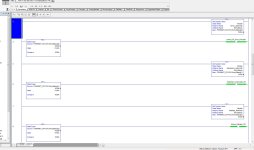AutomationTechBrian
Lifetime Supporting Member
Easy, basic question... this is my first time linking 3 ABB vfds to an Allen-Bradley PLC using ethernet IP, and the odva Drive assemblies 123 and 173. If communication is lost to one of the drives, I would like an indicator light to show up on the HMI for that drive. I could come up with a couple of ways to try doing that, maybe with the drive ready bit. This is such a basic need but I would guess there is a best practice for accomplishing this. Any input? I would also want to make sure the controls were disabled if one of the drives loses communication. Seems to me there should be a bit somewhere for that.




